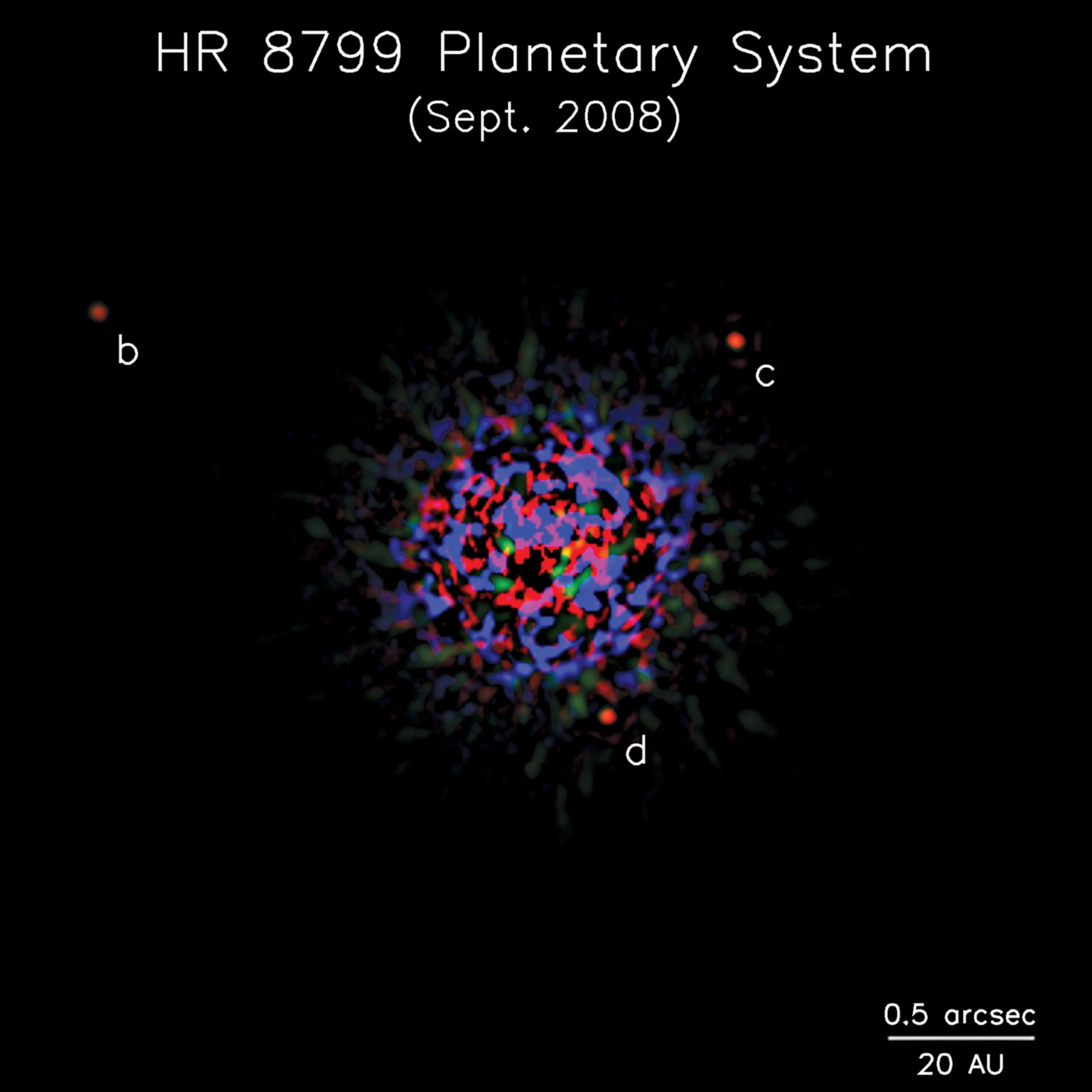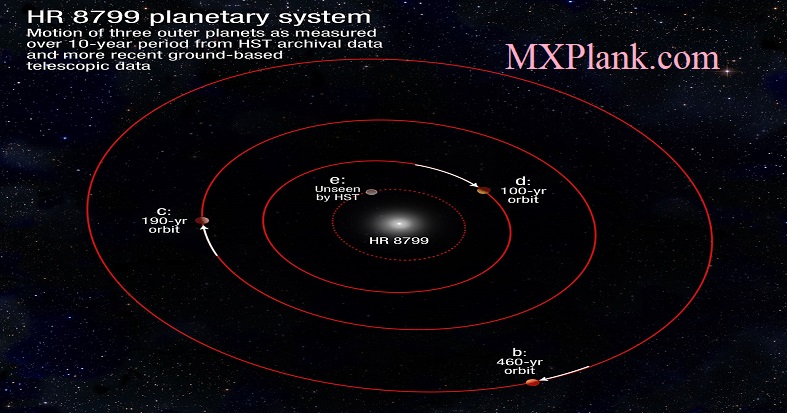This image shows the motion of three of the outermost planets in the HR 8799 system as measured over a 10-year period from Hubble Space Telescope archival data and more recent ground-based telescopic data.
HR 8799, star that has the first extrasolar planetary system to be seen directly in an astronomical image. HR 8799 is a young (about 60 million years old) main-sequence star of spectral type A5 V located 128 light-years from Earth in the constellation Pegasus. Observations of this star taken by the Infrared Astronomical Satellite and the Infrared Space Observatory showed a disk of dust such as that expected in the last stages of planetary formation. In 2008 an international team of astronomers released images taken with the telescopes at the Keck and Gemini North observatories of three planets orbiting HR 8799. A fourth planet was discovered in 2010. Observations show that the planets move with the star and therefore are not background objects. The planets range in mass from 7 to 10 times that of Jupiter and orbit between 2.2 and 10.2 billion km (1.3 and 6.3 billion miles) from HR 8799. These planets are gas giants with temperatures of about 900 to 1,100 kelvins (600 to 800
oC, or 1,200 to 1,500
oF).

All four planets orbiting the star HR 8799 were identified via direct imaging - a feat made possible only because of the planets' large sizes and their wide orbits. Planetary systems with these characteristics often have difficulty holding themselves together under all of the gravitational influences involved. But could the HR 8799 system somehow stay intact?
Subtracting Light to Find Planets
The direct imaging technique involves taking an image of a star and removing all the light associated with the star to see what remains (hopefully planets!). When astronomers used this technique on infrared observations of the star HR 8799, they discovered four planets in orbit around it.
Images show that the innermost planet lies roughly 16 astronomical units from the star - a bit nearer than Uranus is to the Sun - and all of the planets have orbital periods ranging from 50 to 500 years. But, given that astronomers haven't been able to observe this system for very long, uncertainty remains about the long-term behavior of the planetary orbits in the HR 8799 system. In fact, some previous studies have suggested that the system might come apart in the distant future.
But in a recent study, Krzysztof Gozdziewski and Cezary Migaszewski (Nicolaus Copernicus University, Poland) consider a scenario in which the HR 8799 is able to remain intact - we just need to involve mean-motion resonance (MMR) and periodic orbits.
Resonance and Periodic Orbits
When orbiting bodies are in MMR, the ratio of their orbital periods is a small integer ratio (a 5:2 resonance, for example, means that one object orbits five times in the time it takes the other to orbit twice). There are examples of MMR in the solar system: Neptune and Pluto are in a 3:2 resonance, and Jupiter's moons Io, Europa, and Ganymede are in a 4:2:1 resonance.
Gozdziewski and Migaszewski have previously demonstrated that the four planets orbiting HR 8799 could be in a stable 8:4:2:1 MMR. In this study, they revisited the MMR of the HR 8799 planets in the context of periodic orbits, where particular elements associated with the planetary orbits vary periodically with time.
Mass Determination from Models
plot of mass of planet vs. observational epoch. curve stabilizes after ~3 years at 7 jupiter masses.
Gozdziewski and Migaszewski used observations from a particular point in time to create an initial model of the HR 8799 system. They then let the system evolve under the constraints of MMR and periodic orbits. The resulting model not only aligned with measurements of the system made since the initial observation, but it could also be used to determine the masses of the HR 8799 planets. All we'd need is a few more future observations!
HR 8799 could have planets that are closer in than the known four. However, they might not drastically interfere with MMR in the system. In either case, HR 8799 is a good testing ground for theories of planetary formation - we just need to keep an eye on it!
Citation:
"An Exact, Generalized Laplace Resonance in the HR 8799 Planetary System," Krzysztof Gozdziewski and Cezary Migaszewski 2020 ApJL 902 L40. doi:10.3847/2041-8213/abb881

